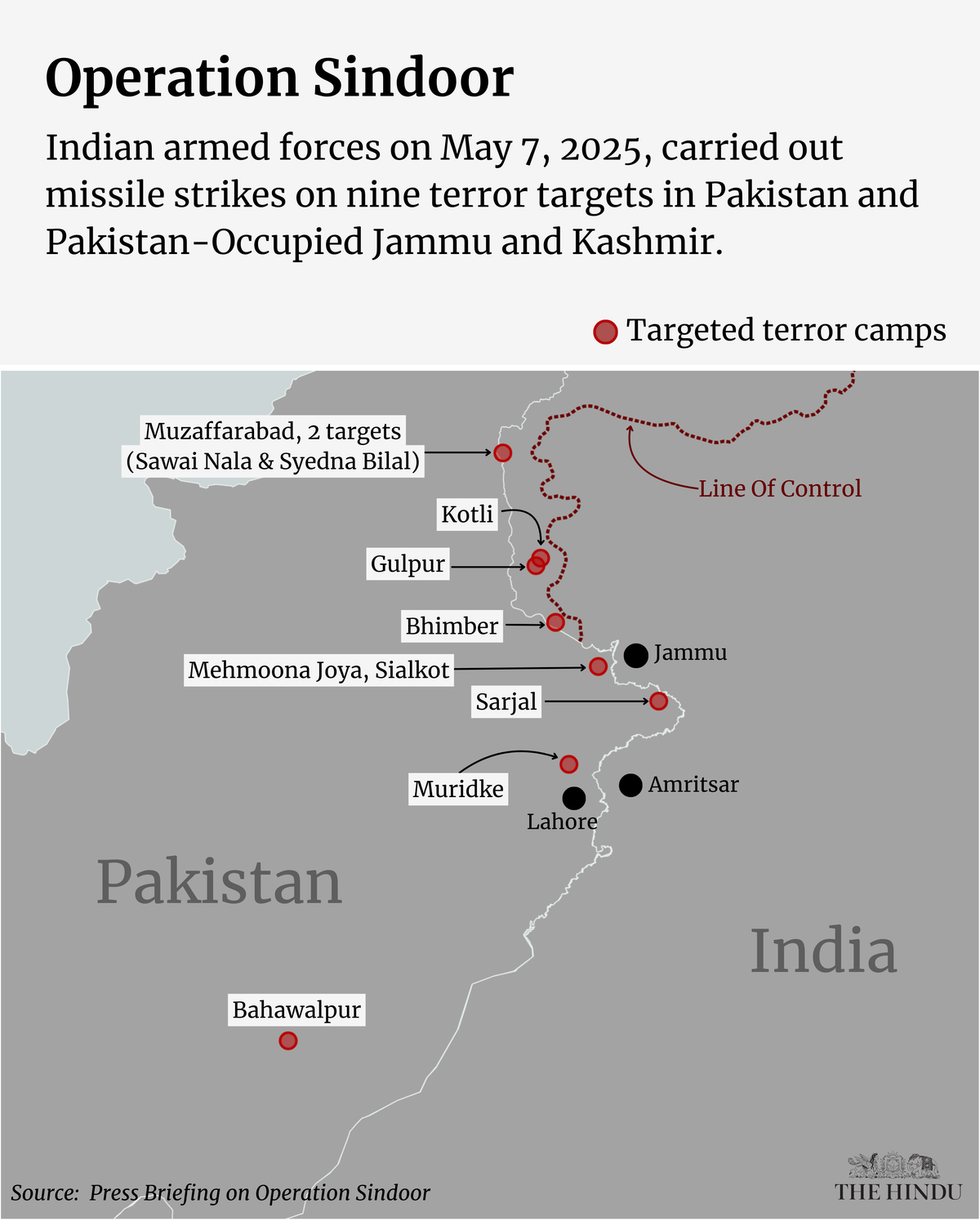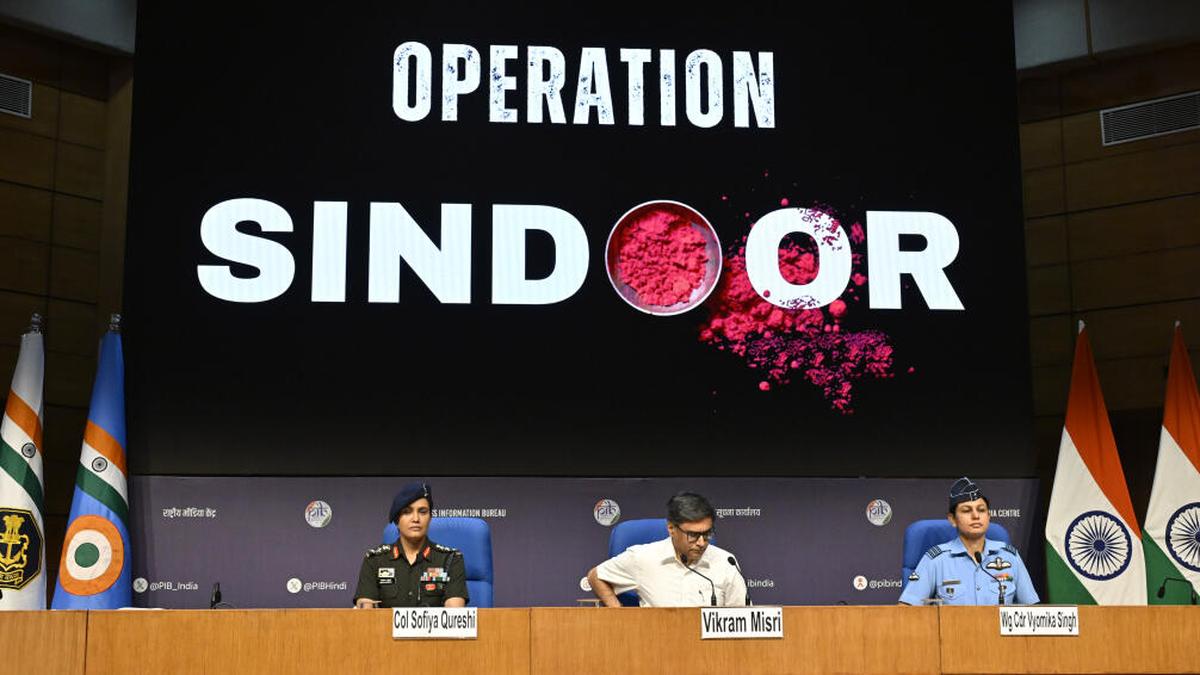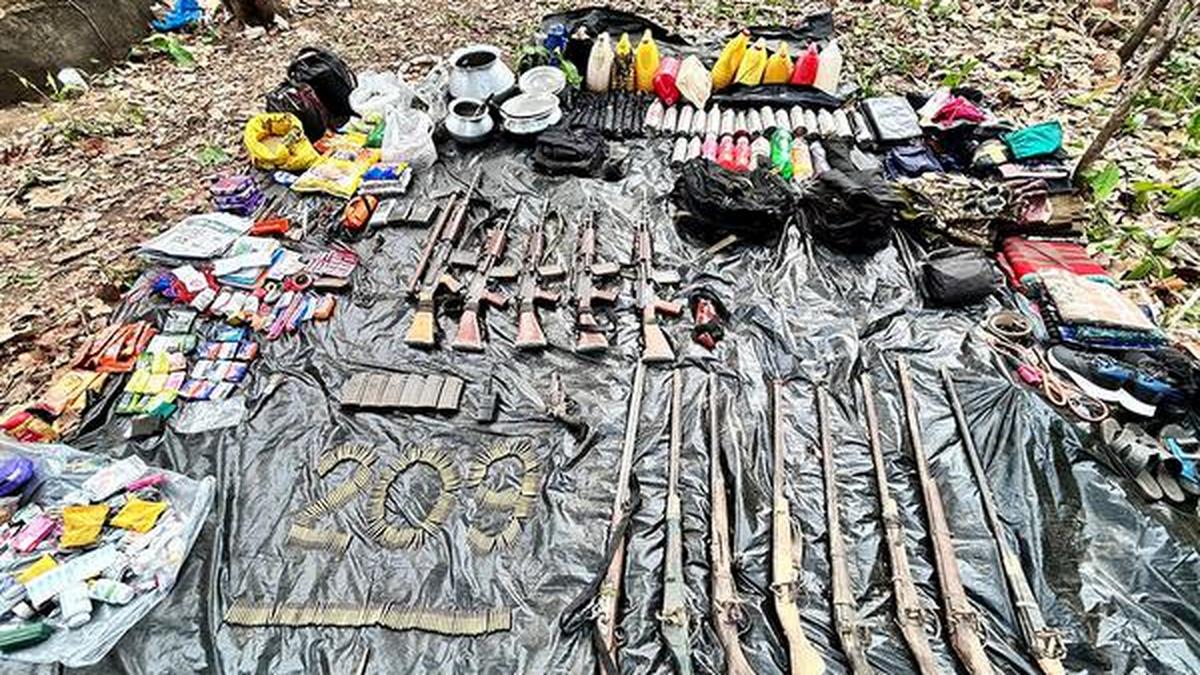Foreign secretary Vikram Misri (centre), Col. Sofiya Qureshi (left) and Wing Commander Vyomika Singh during a press briefing regarding “Operation Sindoor” at the National Media Centre in New Delhi on May 7, 2025.
| Photo Credit: Shiv Kumar Pushpakar
Story so far: The Indian Armed forces conducted missile strikes on nine terror camps in Pakistan and Pakistan-occupied Kashmir (PoK) on Wednesday (May 7, 2025), in retaliation to the terror attack in Pahalgam on April 22, in which 25 Indians and a Nepali citizen were killed. The targeted terror sites include Bahawalpur (Jaish-e-Mohammad (JeM) stronghold) and Muridke (Lashkar-e-Taiba’s (LeT) base).
Briefing reporters on ‘Operation Sindoor’, Colonel Sofiya Qureshi said, “The Armed forces conducted Operation Sindoor on the night between May 6 and 7 at 1.05 a.m. and 1.30 a.m. Nine terror camps were targeted and completely destroyed them. Terror infrastructures such as centres for recruitment, indoctrination and launch pads are present in Pakistan and PoK.”
Wing Commander Vyomika Singh added, “The terror camps are distributed across PoK from Sawai-Nala in the North, counting upto 21, ending at Bahawalpur in the South. Selection of targets for Operation Sindoor were based on intelligence reports and the role of these facilities in perpetrating terror activities. The locations were so selected to avoid damage to civilian infrastructures and loss of civilian lives.”
This is the third such punitive strikes against terror infrastructure in Pakistan and PoK by India after the 2016 surgical strikes and the 2019 Balakot airstrikes. While the surgical strikes were in response to the Uri terror attack in which JeM terrorists killed 19 soldiers, the Balakot strike was in response to the Pulwama attack in which 40 CRPF personnel were killed.
Here’s a look at IAF’s targets and operational details
Within PoK
Sawai Nala (Muzaffarabad): An LeT centre where terrorists involved in attack on Sonmarg, Gulmarg (October 2024) and Pahalgam (April 2025) were trained.
Syedna Bilal (Muzaffarabad): A JeM staging area which also housed weapons, explosives and offered jungle survival training.
Gulpur (Kotli): An LeT base camp, 30 km away from LoC which was active in Rajouri and Poonch areas of Jammu. Terrorists responsible for attacks on buses of pilgrims on April 2023 and June 2024 were trained within PoK.
Barnala (Bhimber): A weapons-handling and explosives and jungle survival training centre.
Abbas (Kotli): Located 13 km away from LoC, LeT terrorists especially Fidayeen (guerilla attackers) were trained in Abbas. The camp had the capacity to train upto 15 terrorists.

Within Pakistan
Sarjal (Sialkot): Located 6 km away from the international India-Pakistan boundary, the terrorists who killed four J&K police personnel in March 2025, were trained here.
Mehmoona Joya (Sialkot): Located 12-18 km away from the international border, this camp was large base for Hizbul Mujahideen. It was the control centre for attacks on Kathua, Jammu and was where the Pathankot airforce base attack was planned and directed.
Markaz Taiba (Muridke): Atleast 18-25 km away from the border, this camp trained terrorists like Ajmal Kasab and David Headley for the 2008 Mumbai terror attacks. Visuals show that IAF hit this camp atleast four times with missiles.
Markaz Subhanallah (Bahawalpur): Located 100 km away from the border, this was the headquarters of JeM and served as a recruitment, training, and indoctrination camp. Top terror outfit leaders often visited here.
The visuals shown by the military officials display buildings present before and the debris after the missile strikes. No civilian casualties were reported in Pakistan as of Wednesday (May 7, 2025) afternoon.
The strikes were undertaken through precision capabilities and the warheads selected as such that there would not be any collateral damage, said Wing Commander Singh. “None of the military installations of Pakistan were targeted. India has been restrained in its response. But the Indian Armed forces are prepared to counter any misadventures by Pakistan to escalate this situation,” she concluded.
Loitering munitions, also known as ‘suicide drones,’ were deployed specifically in Operation Sindoor for precision strikes. These unmanned aerial vehicles are designed to hover over a target area, identify threats, and engage them precisely, minimising collateral damage. Unlike traditional missiles, loitering munitions can wait for the optimal moment to strike. Once locked onto a target, they crash into it and explode.
At least 10 civilians were killed and over 30 were injured as Pakistan resorted to firing and shelling along LoC after Operation Sindoor. Houses and shops were damaged in Pakistan’s mortar shelling in Poonch, Kupwara and Baramulla district.
What has been Pakistan’s response?
Pakistan’s Army spokesman Lt. Gen. Ahmed Sharif Chaudhry stated that India’s missile attacks were launched from its own airspace and that all planes of Pakistan Air Force were airborne. “Pakistan will respond to this at a time and place of its own choosing. This heinous provocation will not go unanswered,” he added.
In a National Security Council meeting chaired by Pakistan Prime Minister Shehbaz Sharif, he authorised the armed forces to undertake retaliation to ‘avenge loss of Pakistani civilian lives’. It is unclear how many civilians have died in Pakistan and PoK due to Operation Sindoor.
Its Foreign Ministry spokesperson has said that “Pakistan reserves the right to respond appropriately at a time and place of its choosing, in accordance with the Article-51 of the UN Charter, and as enshrined in international law”.
Published – May 07, 2025 08:13 pm IST






